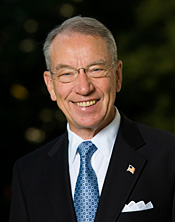From Senator Charles Grassley –

Q: What is the status of the farm and food bill?
A: The clock is ticking for the U.S. Senate and House of Representatives to renew the federal farm and food bill that would set public policy for agriculture, nutrition, conservation, disaster assistance and rural development for the next five years. In fact, nearly 80 percent of the funding is geared towards nutrition programs such as the Supplemental Nutrition Assistance Program (or food stamps), the Temporary Emergency Food Assistance Program, and other food-assistance programs for seniors and children. Only about 20 percent of the funding for the farm and food bill is directed towards agriculture programs. Farm and food policy have been linked for decades in order to secure political support for both. That pairing is likely to continue, at this point, but I don’t like farmers getting the blame for the spending in the bill when agriculture programs receive a minor percentage of the funding. The most recent law expired September 30, and until Congress reaches an agreement, a quirk in the law automatically reverts federal farm policy to permanent Depression-era laws adopted in 1938 and 1949. Lawmakers now must iron out the differences between their respective versions before Congress sends a final bill to the White House for the President’s signature. It’s time to get the job done. Congress needs to pass a farm and food bill that will give farmers the certainty they need to plan for the next planting season and maintain sound stewardship of financial and natural resources upon which their livelihood and way of life depends.
Q: What needs to happen?
A: U.S. farm and food policy needs to maintain a sufficient 21st century farm safety net that supports rural America and America’s food producers who grow the safest, most affordable and most abundant food supply in the world. We can’t afford to let federal farm and food policy unravel into uncertainty. The next farm and food bill also needs to protect taxpayers. America can’t tax, spend and borrow its way to prosperity. Reckless federal spending is piling up to unsustainable levels of national debt. The public purse needs to protect the public good, from national security to food security. Lawmakers need to make sure taxpayers get the most bang from every buck, including spending for American agriculture and nutrition. I’m leading the effort for reforms that end automatic federal farm payments and tighten loopholes that are harming the integrity of federal farm programs. Consider nationally that 10 percent of payment recipients receive 72 percent of farm program payments. The farm safety net needs to empower farmers and producers to better manage their risk and protect soil and water quality.
Q: Which payment reforms do you consider untouchable in negotiations on the farm and food bill?
A: As one of two working family farmers serving in the U.S. Senate, I work to give a strong voice to American agriculture. I’m also committed to getting Washington to do a better job of tightening its belt. This year I secured two reforms that are included in both the Senate and House versions of the farm and food bill, including a fixed maximum annual payment limitation of $250,000 per married couple and an explicit directive that gives teeth to the definition of “actively engaged in farming.” Unfortunately, federal farm payments have flowed to non-farmers gaming the system. These types of shenanigans are indefensible and have no place in the farm and food safety net. An investigation I requested by the nonpartisan Government Accountability Office exposes flaws in the system, including a legal loophole that gives the program a black eye. In its 60-page report, the GAO cited an example of a farm that received $400,000 in farm subsidies in 2012. In a complex legal arrangement, the farm was organized as a general partnership, with six corporations and 11 members of the same family, ages 18-88. The legislative reforms I championed in the Farm Program Integrity Act of 2013 are mirrored in the farm bill currently being negotiated in Congress. It would change the definition to allow only one off-farm manager, which would help to crack down on general partnerships that are created to exploit the system to qualify for farm payments. The farm safety net is intended to help those who grow our food to stay afloat when times are tough. It’s not intended to allow gougers to help themselves to feed at the taxpayers’ trough. By closing these loopholes and limiting lopsided farm payments, we can strengthen America’s farm safety net.
Thursday, October 24, 2013






